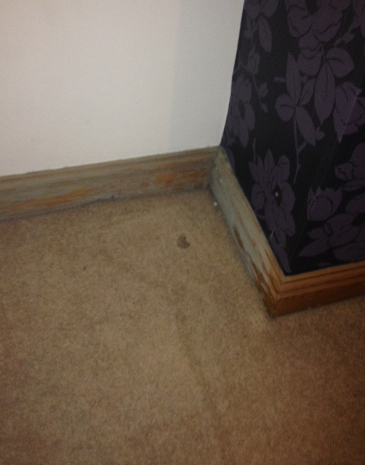Find a Mold Specialist Now
Click or Call, Toll-Free 24/7
mold identification
People often wonder about mold identification when they find mold growing somewhere in their home. They wonder what type of mold it is and if it might be toxic black mold. You can do a toxic mold test to see if it is toxic black mold, or stachybotrys chartarum, but you should know that all types of mold are harmful. All types of mold can damage your home and all types can cause health problems. Follow these links to read more about how mold can damage your home and to learn more about health problems caused by mold.
Mold Identification
 Visable mold on molding and floors
Visable mold on molding and floorsYou can’t tell what type of mold is growing in your home just by looking at it. The Centers for Disease Control and Prevention estimates there are more than 300,000 different strains of mold in existence and many of those are similar in appearance. For example, aspergillus, penicillum and cladosporium can all appear green in color. In addition, some kinds of mold can look different depending on where they are located and how much of the mold is there. For instance, stachybotrys chartarum, often referred to as black mold, isn’t always black. Sometimes it looks green in color instead.
You can read more about common types of mold here. You can make an educated guess based on the color and texture of the mold and where it is growing, but it will only be a guess. The only way to know for certain what kind of mold is growing in your home is to test the mold.
Do You Need a Toxic Mold Test?
The Centers for Disease Control and Prevention (CDC) says that in most cases, you don’t need to know what kind of mold is growing in your home because all types of mold are harmful. No matter what kind is growing in your home, you’ll need to have it removed.
However, the U.S. Environmental Protection Agency (EPA) does suggest testing for mold after having mold removed from your home in order to make sure the mold removal was complete. If even a small amount of mold is left behind, it could grow and spread and you’ll soon have a full-blown mold problem on your hands again. So while you may not need to test the mold in your home for mold identification purposes prior to having the mold removed, you should consider testing for mold after having the mold removed just to be sure the job was done correctly and completely.
What If You Have Mold-Related Health Problems?
Let us begin by saying we cannot give medical advice here. We encourage you to ask your doctor if it is important to know what type of mold you’re dealing with in order to get the proper treatment and then follow his or her recommendations. However, we can give you some general information.
While it is important for your doctor to know if mold exposure is causing or contributing to your symptoms, your treatment may not be affected by knowing what kind of most is causing the problem. In other words, your doctor may treat your mold-related sinus infection the same way no matter what type of mold is in your home.
There may be some instances in which knowing the type of mold to which you’ve been exposed would affect the recommended treatment, however. If you know what kind of mold is in your home, let your doctor know. If your doctor believes it is important to have that information, he or she may be able to order some blood tests to check for antibodies to specific strains of mold or you and your doctor may decide it is worth your while to have a mold identification test done in your home.
If you have mold-related health problems, you’ll need to have all traces of mold removed from your home in order to recover fully, so even if you don’t test the mold to find out what kind it is, you’ll want to test your home after the mold has been removed to make sure it is all gone.
Testing for Mold
If you need to test your home for mold, the Environmental Protection Agency recommends hiring a professional mold tester that follows the best practices outlined by industry organizations like the American Conference of Governmental Industrial Hygienists and the American Industrial Hygiene Association. That way you’ll get accurate information that is useful to you. For a list of experienced professional mold testers in your area, just follow the link.
Return From Mold Identification To Our Main Testing Page
References:
Privacy Policy Terms and Conditions Accessibility Do Not Sell My Information Disclaimer Contact Us




